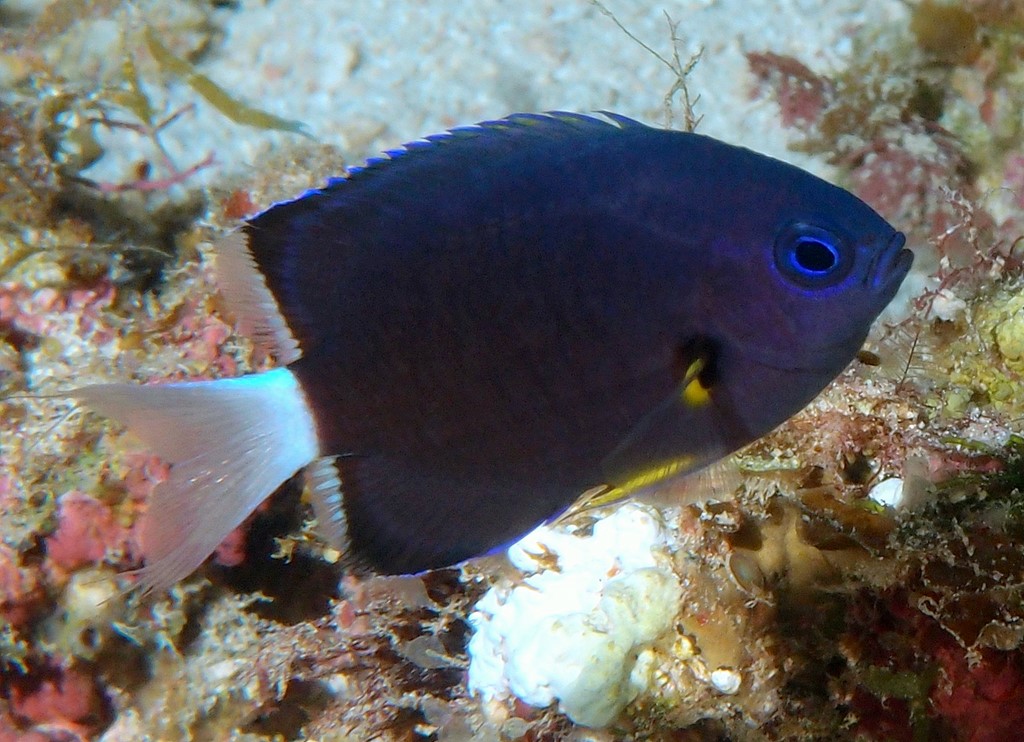PYCNOCHROMIS LEUCURUS - (GILBERT, 1905)
Actinopterygii (Gigaclass) > Actinopteri (Class) > Teleostei (Subclass) > Blenniiformes (Order) > Pomacentridae (Family) > Chrominae (Subfamily) > Pycnochromis (Genus)
Demoiselle à queue blanche, Whitetail chromis, White-tailed chromis, Fukamisuzumedai, フカミスズメダイ, 亮光鰓魚,
Synonymes
Chromis leucura (Gilbert, 1905)
Chromis leucurus (Gilbert, 1905)
Chromis leucura (Gilbert, 1905)
Chromis leucurus (Gilbert, 1905)
------------------------------
Description
Dorsal spines (total): 12; Dorsal soft rays (total): 14; Anal spines: 2; Anal soft rays: 13-15 (rarely: 15); Upper and lower spiniform caudal rays: 2; Pectoral fin rays: 16-17; Gill rakers: 24-27 (total first arch); Tubed lateral-line scales: 13-15. Margin of preopercle smooth; Free edge of suborbital reaching to below rear edge of pupil; Body depth: 1.9-2.15 in Standard Length; Caudal fin forked, the second upper and lower branched rays prolonged as filaments. Max. length : 8.5 cm TL. Depth range: 20 - 119 m.
Dorsal spines (total): 12; Dorsal soft rays (total): 14; Anal spines: 2; Anal soft rays: 13-15 (rarely: 15); Upper and lower spiniform caudal rays: 2; Pectoral fin rays: 16-17; Gill rakers: 24-27 (total first arch); Tubed lateral-line scales: 13-15. Margin of preopercle smooth; Free edge of suborbital reaching to below rear edge of pupil; Body depth: 1.9-2.15 in Standard Length; Caudal fin forked, the second upper and lower branched rays prolonged as filaments. Max. length : 8.5 cm TL. Depth range: 20 - 119 m.
Color
Body dark brown to deep blue with yellow ventral fins and white tail; Black edge marking extends from rear dorsal fin to rear anal fin, black spot covers pectoral fin base.
Body dark brown to deep blue with yellow ventral fins and white tail; Black edge marking extends from rear dorsal fin to rear anal fin, black spot covers pectoral fin base.
Etymology
Pycnochromis: from ancient Greek, puknós = dense, compact, thick. Referring to “very smooth” head of Pycnochromis vanderbilti, the “edges of the suborbitals, preopercle and opercle little distinct” + from chromis: from Greek, chroemo = to neigh. A name dating to Aristotle, referring to a drum (Sciaenidae) and its ability to make noise; Later applied to this damselfish and subsequently expanded to embrace dottybacks, cichlids and wrasses (all perch-like fishes once thought to be related).
leucurus: from Greek, leukós = light in color; white + from ancient Greek, ourá = tail, queue, line of people. Referring to white caudal fin and posterior half of caudal peduncle.
Original description: Chromis leucurus Gilbert, 1905 - Type locality: Avau Channel, between Maui Island and Lanai Island, Hawaiian Islands, Albatross station 3875, depth 34-65 fathoms.
Pycnochromis: from ancient Greek, puknós = dense, compact, thick. Referring to “very smooth” head of Pycnochromis vanderbilti, the “edges of the suborbitals, preopercle and opercle little distinct” + from chromis: from Greek, chroemo = to neigh. A name dating to Aristotle, referring to a drum (Sciaenidae) and its ability to make noise; Later applied to this damselfish and subsequently expanded to embrace dottybacks, cichlids and wrasses (all perch-like fishes once thought to be related).
leucurus: from Greek, leukós = light in color; white + from ancient Greek, ourá = tail, queue, line of people. Referring to white caudal fin and posterior half of caudal peduncle.
Original description: Chromis leucurus Gilbert, 1905 - Type locality: Avau Channel, between Maui Island and Lanai Island, Hawaiian Islands, Albatross station 3875, depth 34-65 fathoms.
Distribution
Indo-West Pacific: Madagascar and Mascarenes east to Hawaiian Islands, Marquesas Islands and Gambier Islands, north to southern Japan, south to New Caledonia.
Indo-West Pacific: Madagascar and Mascarenes east to Hawaiian Islands, Marquesas Islands and Gambier Islands, north to southern Japan, south to New Caledonia.
Biology
Adults are found in aggregations near ledges and deep patch reefs. Benthopelagic. Life history characteristics for the family specify that this group is oviparous, with distinct pairing during breeding. Eggs are demersal and adhere to the substrate. Males guard and aerate the eggs. Aquarium fish (rare).
Adults are found in aggregations near ledges and deep patch reefs. Benthopelagic. Life history characteristics for the family specify that this group is oviparous, with distinct pairing during breeding. Eggs are demersal and adhere to the substrate. Males guard and aerate the eggs. Aquarium fish (rare).
Last update: 20, September 2021
